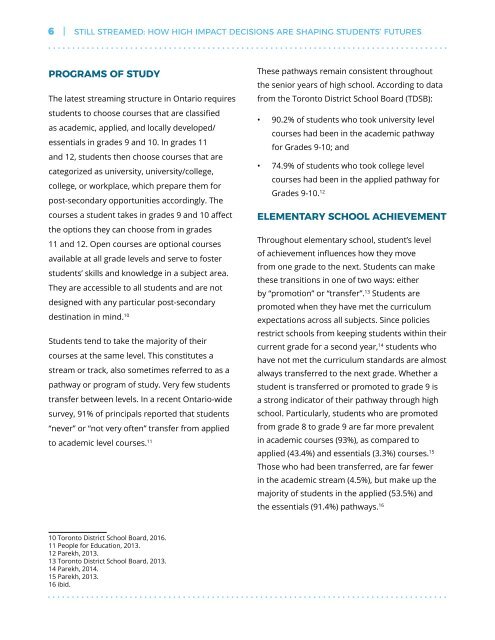Streaming_Report-September-v1.1-web
Create successful ePaper yourself
Turn your PDF publications into a flip-book with our unique Google optimized e-Paper software.
6 | STILL STREAMED: HOW HIGH IMPACT DECISIONS ARE SHAPING STUDENTS’ FUTURES<br />
PROGRAMS OF STUDY<br />
The latest streaming structure in Ontario requires<br />
students to choose courses that are classified<br />
as academic, applied, and locally developed/<br />
essentials in grades 9 and 10. In grades 11<br />
and 12, students then choose courses that are<br />
categorized as university, university/college,<br />
college, or workplace, which prepare them for<br />
post-secondary opportunities accordingly. The<br />
courses a student takes in grades 9 and 10 affect<br />
the options they can choose from in grades<br />
11 and 12. Open courses are optional courses<br />
available at all grade levels and serve to foster<br />
students’ skills and knowledge in a subject area.<br />
They are accessible to all students and are not<br />
designed with any particular post-secondary<br />
destination in mind. 10<br />
Students tend to take the majority of their<br />
courses at the same level. This constitutes a<br />
stream or track, also sometimes referred to as a<br />
pathway or program of study. Very few students<br />
transfer between levels. In a recent Ontario-wide<br />
survey, 91% of principals reported that students<br />
“never” or “not very often” transfer from applied<br />
to academic level courses. 11<br />
These pathways remain consistent throughout<br />
the senior years of high school. According to data<br />
from the Toronto District School Board (TDSB):<br />
• 90.2% of students who took university level<br />
courses had been in the academic pathway<br />
for Grades 9-10; and<br />
• 74.9% of students who took college level<br />
courses had been in the applied pathway for<br />
Grades 9-10. 12<br />
ELEMENTARY SCHOOL ACHIEVEMENT<br />
Throughout elementary school, student’s level<br />
of achievement influences how they move<br />
from one grade to the next. Students can make<br />
these transitions in one of two ways: either<br />
by “promotion” or “transfer”. 13 Students are<br />
promoted when they have met the curriculum<br />
expectations across all subjects. Since policies<br />
restrict schools from keeping students within their<br />
current grade for a second year, 14 students who<br />
have not met the curriculum standards are almost<br />
always transferred to the next grade. Whether a<br />
student is transferred or promoted to grade 9 is<br />
a strong indicator of their pathway through high<br />
school. Particularly, students who are promoted<br />
from grade 8 to grade 9 are far more prevalent<br />
in academic courses (93%), as compared to<br />
applied (43.4%) and essentials (3.3%) courses. 15<br />
Those who had been transferred, are far fewer<br />
in the academic stream (4.5%), but make up the<br />
majority of students in the applied (53.5%) and<br />
the essentials (91.4%) pathways. 16<br />
10 Toronto District School Board, 2016.<br />
11 People for Education, 2013.<br />
12 Parekh, 2013.<br />
13 Toronto District School Board, 2013.<br />
14 Parekh, 2014.<br />
15 Parekh, 2013.<br />
16 ibid.

















